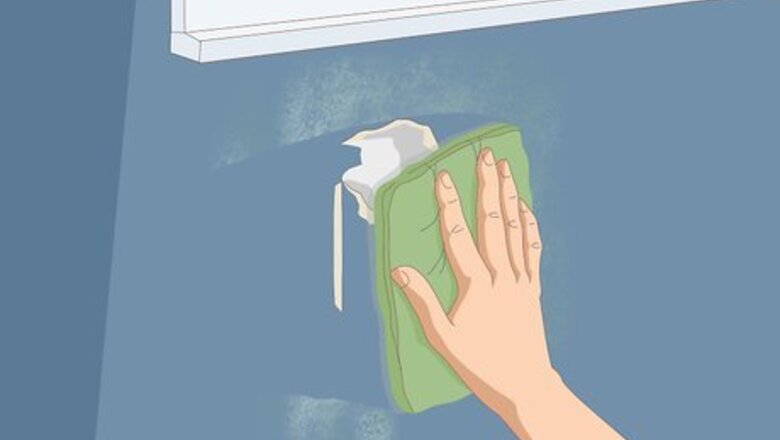
views
Patching over Minor Peels
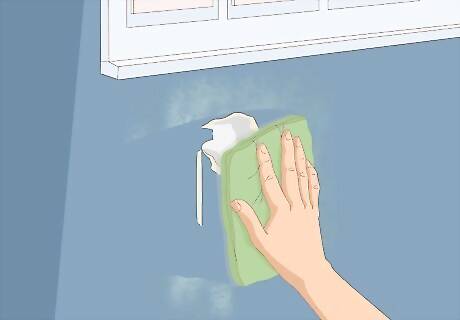
Use a clean cloth to wipe the wall down. Take a clean, dry cloth and run it over the section of the peeling tape that you’re going to patch. Rub lightly to remove most of the dust or debris that’s covering the area that you’re going to cover. Let any chunks of drywall or chips of paint fall to the floor. This method is preferred if you have a very minor peel that isn’t exposing a lot of drywall. This repair won’t last forever, but it will keep smaller issues from getting worse. If a length of tape longer than 1 foot (0.30 m) is coming off, consider replacing it entirely. If you’re worried about creating a mess on your floor, put a drop cloth down under the area that you’re patching.

Add fast-setting joint compound to a mud pan with a putty knife. You can use standard setting compound if you want, but fast-setting joint compound will keep moisture from getting trapped in the walls. Use your putty knife to scrape some putty out of the container. Place your putty knife in the mud pan and slide your loaded blade over the sharp interior-edge of the mud pan to keep the compound inside. You can really use any kind of spackling paste to cover a hole in drywall, but fast-setting joint compound will be stronger and won’t take as long to dry. Standard setting compound has to be mixed with water until it becomes a thick paste. If the hole created by your peeling tape is less than 1 foot (0.30 m) in length, you won’t need more than 1 scoop of joint compound.

Spread the joint compound over the peel and scrape it flat. Use the blade of your putty knife to scoop some joint compound out of the pan. Place the blade at the top or end of the gap in your wall. Keep the blade pressed down with your index finger and drag your putty knife at a 45-degree angle over the hole. Press firmly, but softly enough to leave joint compound behind. Continue adding compound until you’ve covered the hole and the compound is mostly flat. Cover the hole 4–5 inches (10–13 cm) in both directions of the tear to keep the tape from continuing to peel in the near-future. Scrape an area 2-3 times to add additional pressure if you want to force the compound all the way into the gap.

Wait at least 12 hours for the fast-setting joint compound to dry. Your fast-setting dry compound may list the waiting time anywhere from 30 minutes to 6 hours on the packaging. To be on the safe side, give the compound at least 12 hours to completely dry out. Your compound is dry when it’s entirely gray in color, and totally dry when you touch it. After 12 hours, run your palm over the joint compound. If it’s chalky and dry, you’re ready to move on. The deeper the hole in your wall is, the longer you need to wait. Twelve hours should be more than enough time to dry the fast-setting compound out.
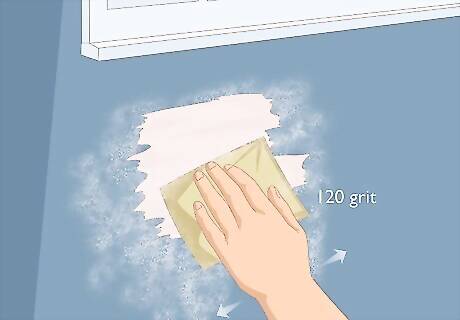
Sand the surface that you’ve patched with 120-grit sandpaper. Use a sheet of sandpaper or a sanding sponge to firmly remove layers of joint compound. Scrape using back-and-forth strokes in the same direction that you applied the joint compound. Remove any larger chunks of compound that are sticking out and stop once the area that you’ve patched is flush with your wall. You can tell if the joint compound is flush with the wall by running your hand over it. If you feel bumps or grooves in the wall when you run your hand over the patched wall, then you aren’t done sanding. It doesn’t need to be perfect. If it’s flat enough for you and the peeling tape is completely covered, it should be fine.
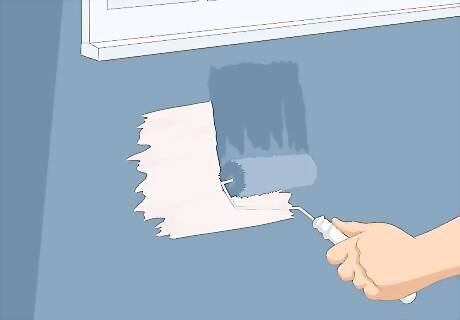
Paint the area that you patched using a brush or roller. After sanding the area, wipe the area you patched with a clean cloth before repainting it. Fill a paint tray with a paint that matches the color on your walls, then paint the patched area with a brush or roller. If the paint looks uneven and like it’s the wrong color, consider repainting the entire wall for a more uniform look.Warning: Watch out for bubbles forming after you’ve painted. If you see the paint to start to bubble up, it means that the joint compound hadn’t fully dried when you painted over it. If this happens, use your scraper to remove the wet compound after the paint dries and redo it. Wait an additional 48-72 hours before patching the drywall again. Depending on the type of paint, size of the patch, and type of joint compound, you may need to prime the wall first to keep the compound from showing through.
Replacing Entire Strips of Tape
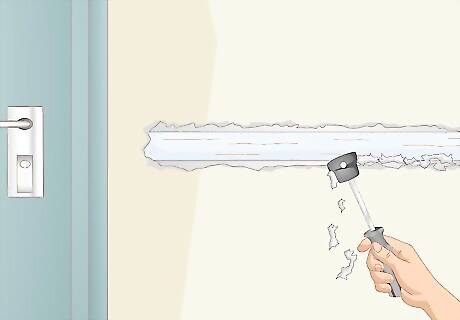
Use a scraper or putty knife to dig under the drywall covering the tape. Take a scraper or putty knife and press it against the wall with your dominant hand. Press the blade down into the wall with your index finger. Repeatedly push the blade against the wall at a 45-degree angle, perpendicular to the crack. Stop once you’ve removed any hanging chunks of drywall or paint and you can visibly see the tape underneath. Chunks of drywall or dried paint may pop off of the wall. It may look like you’re making a mess of things, but don’t worry about it. You need to remove all of the damaged surface before you can replace it. Set out a drop cloth if you’re worried about getting drywall dust all over your floor while you’re doing this.
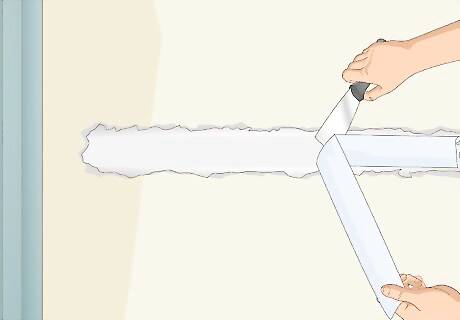
Pry an edge of the tape out with your putty knife and pull it out. Once you’ve got a length of tape exposed, use a putty knife to pry underneath it. Use your fingers to dig under the tape and pull it out working in both directions. It will tear on its own once it gets to a point in the paint where it’s firmly installed. If you break the tape when prying it up, simply pull it out in both directions until it tears on its own. You only need to re-tape the length that’s weak enough to be pulled out on its own. This could be anywhere from 2–3 inches (5.1–7.6 cm) to 5–6 feet (1.5–1.8 m). The length you need to replace is entirely determined by how weak the tape is in the section that’s peeling. It could be the entire length of the tape, or it could be a small section where an air bubble was trapped.
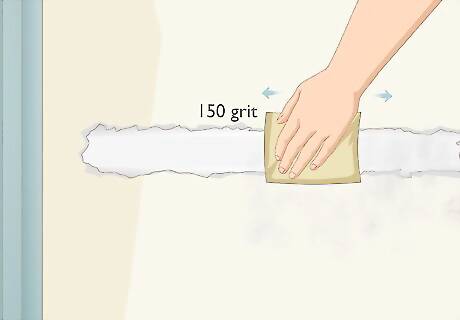
Sand the area that you’ve removed with 150-grit sandpaper. With the tape removed, use 150-grit sandpaper or a sanding sponge to scrape away the excess drywall and paint. Sand using back-and-forth strokes until you’ve entirely covered the area where the paint used to be. Sand on the outside edges where you still have your original paint to get both sides of the gap between the drywall and the paint. You’re going to repaint anyway, so don’t be conservative when it comes to sanding. Try to avoid sanding the drywall paper down at all. There should be a layer of joint compound on top of it where the tape was, but if you see a layer of paper underneath, you’ve gone too far.
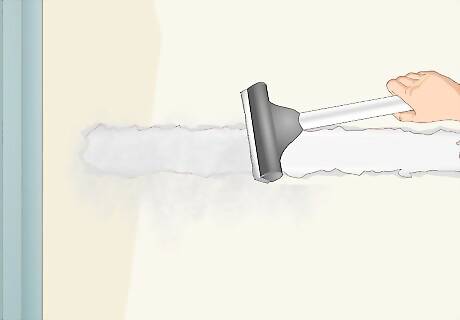
Vacuum the length of wall that you’ve sanded to remove the dust. Get a vacuum with a hose attachment and set it to the highest power setting. Run the hose along the length of wall that you sanded to remove the dust that’s sticking to your walls. This will keep it from getting trapped under your new tape. If your vacuum doesn’t reach the area that you sanded, you can simply wipe it with a dry cloth to knock the dust away.

Replace the tape that you’ve removed with a piece of mesh tape. Pull out a length of mesh drywall tape that’s the exact same size as the piece that you removed. Put one end at the end and pull it out towards the other end. You can smooth the tape down with your hand as you’re applying it or use the edge of your putty knife. If 1–2 inches (2.5–5.1 cm) of tape overlap, that’s fine. Try not to cut it short though. If you’re re-taping a corner, you can use the pre-folded paper tape if you’d like. This type of paper is designed specifically for corners.
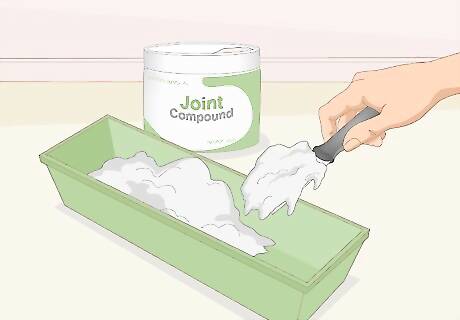
Fill a mud pan with joint compound using your putty knife. Scoop putty compound out with a putty knife and put it into the mud pan. Use the sharp edge of the mud pan and the flat blade of the putty knife to scrape the putty into the pan. It’s easier to use pre-mixed joint compound, but you can get the cheaper joint compound and mix it with water yourself if you’d like. The amount of joint compound that you need is dependent upon how big the chunk of wall you sanded down is. In general, .05 pounds (23 g) of joint compound will cover 1 square foot (0.093 m) of wall.
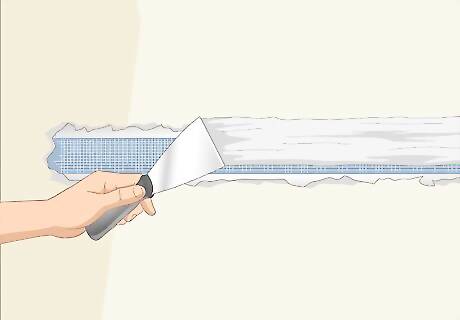
Apply the joint compound over your mesh tape, scraping in the direction of the tape. Use the tip of your putty knife to scoop up some joint compound. Rub the tip of the putty knife over a section of the tape by holding the blade at a 45-degree angle. Rub the joint compound into an area and then use the empty putty knife to spread it out by scraping it. Repeat this process for each area that’s missing paint or was sanded down. You do not want giant globs of joint compound sticking to you wall. The compound should be nearly flush with your wall, but thick enough to visibly cover the tape. If you leave a bunch of clumps of joint compound, you’ll have to sand really hard to get it flush with you wall. If you’re doing this in a corner, start right where the walls form a 90-degree angle and scrape away from the joint to add your compound. Do this in both directions.
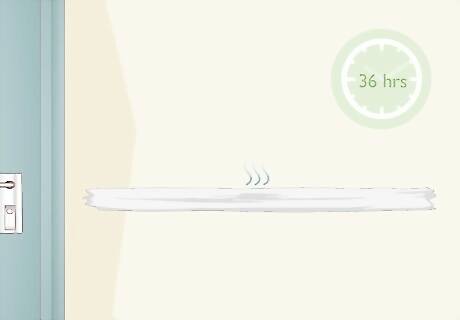
Wait at least 36 hours for your joint compound to dry. Joint compound can take a long time to dry, and your wall will start to bubble up if you don’t give it time to air out. After at least 36 hours, inspect the compound to see if it’s a pale gray. If any sections are a little browner than others, it hasn’t fully dried. If it’s gray, run your palm lightly over the surface where you applied the compound. If the wall is hard, and chalky, it’s fully dried. If there’s a fan in the room, turn it on. The compound doesn’t necessarily require ventilation to dry, but the joint compound will dry more thoroughly if there’s some air flow in the room.
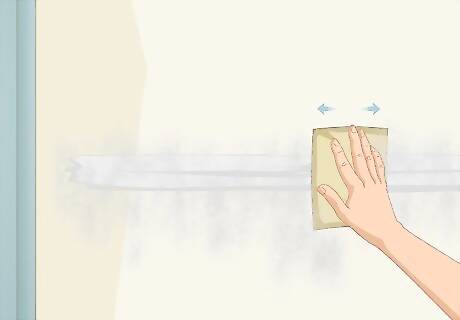
Sand the area where you applied joint compound to smooth the surface. Use 100-150 grit sandpaper or a sanding brick. Scrape in the direction of the tape using firm back-and-forth strokes to remove any pieces of joint compound that aren’t flush with your wall. Continue sanding until the unrepaired wall and the joint compound are flush with one another. It can be a little hard to tell when you’re done sanding. In general, if you’ve sanded every section at least once and the wall looks smooth enough for you, you’re fine. If any big chunks of joint compound fall off, you’ll need to re-patch it using the same method. Wait at least 72 hours for the second coat to dry though.
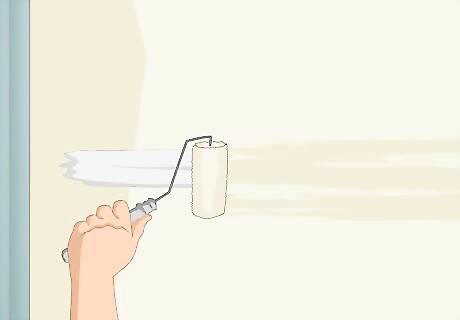
Paint the area that you covered in joint compound. After you’ve smoothed the entire section out, use a brush or roller to apply paint to the patched area. You can use the same color as the rest of your wall if you only want to paint that smaller section, or you can repaint the entire wall to give it a fresh look.Tip: Depending on the type of joint compound, the size of the patch, and the type of paint that you’re using, you may need to prime the wall first to keep the joint compound from shining through. If you’re using a flat paint, have a bigger patch, or used slow-drying joint compound, prime the section you fixed first. You’ll need to repaint the whole wall if you want the paint job to be uniform if your walls are really old and haven’t been painted in a while.












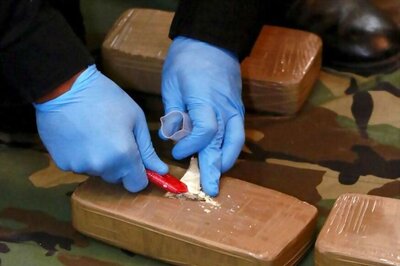





Comments
0 comment